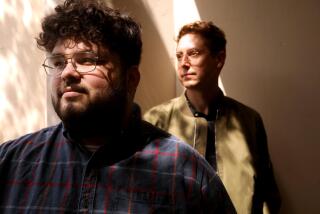Center’s Grads Share Hopes, Dreams : Crittenton More Than a Shelter to Teen-Age Girls, Babies
- Share via
The aging three-story yellow stucco building that is Crittenton Center sits on the front of a lot so steep that new outdoor facilities, including a patio and a toddlers’ play yard, had to be wedged in back. In 1914, when Crittenton moved to this site, staff member Nancy Tallerino surmises, “Pregnant girls went off to ‘Aunt Sarah’s’ and never went outside until they were no longer pregnant.”
Times, and mores, have changed. Each year in Los Angeles County 17,000 teen-agers, the vast majority unmarried, give birth. Among their peers, there is no stigma attached; indeed, peer pressure not to relinquish custody is so great that about 96% opt to keep their babies.
A few find their way to Crittenton Center for Young Women and Infants, which is a temporary home to young women between 12 and 18, all of them dependents or wards of the Juvenile Court--girls whose emotional, behavioral or social problems preclude living with their natural families.
“We’ve come full circle,” executive director Sharon Watson observed. The first Crittenton Center was a shelter for homeless women that opened in New York in 1883 but, as time passed, the societal need shifted to unwed mothers; the present L.A. facility, on Avenue 33 near the Pasadena Freeway, was built as a maternity home.
Today, Watson said, “about half of my girls are pregnant or are mothers. We’re really back to treating the drug abuser, the prostitute. . . . “
Those accepted at Crittenton, which has beds for 40 girls and 16 children, may stay until they are 18 or, in the case of the mothers, until their children are 3--whichever comes first. Crittenton is a training ground, a place where girls who have never experienced a loving and supportive home life, for whom a high school diploma seems an impossible dream, develop the skills they need to parent, to get a job, to function in society.
Some are as young as 15 or 16 when, with their children, they must move out to make room for others. “Part of the problem is they don’t have anyplace to go from here,” Watson said. “You have someone who was a mother at 12. Now what?”
The system is overloaded, with only two county facilities--Crittenton and Booth Memorial Hospital--having residential facilities for adolescents and their babies, and a paucity of foster homes in the county.
“Gobs and gobs of kids are coming through the system,” Watson said. The typical Crittenton client has come from a home where she was the victim of physical and/or sexual abuse. At the same time, she said, the county is “losing more foster homes than it can recruit,” as women opt to enter the paid work force.
Compounding the shortage, she said, is the fact that “people want kids from 6 to 12”--they don’t talk back as much and they are in school all day. The hardest-to-place groups are adolescents and infants and, she added, “Try to find somebody who’ll take an infant and an adolescent at the same time.”
To meet this need, Crittenton has just received from the county an $82,000 grant to recruit and train foster parents who will open their homes to these teen-agers for average stays of six to nine months. The goal is to certify 10 homes to serve 10-15 adolescent mothers and their children. The start-up target is summer.
Wednesday was graduation day at Crittenton High, the center’s in-house, year-round school. As “Pomp and Circumstance” muffled the cacophony of vociferous infants, five young women, not yet 20 but already survivors, marched up the aisle in garnet caps and gowns.
“Many are the first graduates in their families,” said Nancy Tallerino, treatment director at Crittenton for six years. “A lot of things we take for granted are tremendous accomplishments for these kids.”
There were the usual platitudes spoken at graduations--words about ignoring one’s limitations, reaching for the stars. There was a not-so-usual presentation by the Crittenton Center Chorus of a rock-beat song, “Ain’t No Stopping Us Now.”
Graduate Sally Mitchell, 19, who’d left Crittenton three weeks ago and is on her own now, came 30 minutes late, explaining that she’d been stranded without a ride. As her son, Steven, 3, looked on, Mitchell, who’d lived two years at Crittenton, spoke of her realization that “there’s a lot of people who care for me.
“I’ve been through a whole lot,” Mitchell said, “and I have to pat myself on the back . . . I’m going to make it through college . . . I’m going to succeed . . . “ None of her family had come to the ceremony.
Emotional Speeches
Friends mopped at wet eyes as each graduate spoke. Leticia, 17, an abused child from a substance-abusing home, smiled and said, “I never thought I’d get here . . . it’s hard to believe.” Her daughter, Crystle, 2, done up for the occasion in white lace and pink ribbons, sucked a finger and looked on, wide-eyed.
Later, Leticia spoke of her past--doing drugs, living on the street--and of the future she hopes for--college, a career in child development. She smiled at Crystle and said, “I don’t want her to go through everything I went through.”
Michelle, who will be 19 next month, the only one among the graduates who is not a mother, had come to Crittenton two years earlier, a probation-department referral with a shoplifting arrest. Her background: a single-parent home with an alcoholic mother, sexual molestation by an uncle. She, too, wanted to thank the staff, her teachers and to say to her Crittenton friends, “Take care of yourselves . . . and try to stay out of trouble.”
Sharon Watson watched, obviously moved. Graduation day is always “bittersweet,” she said. “They’re thrilled with themselves, but it’s hard to leave.”
Tallerino knows what the Crittenton graduates face in the real world. Realistically, she said, their first jobs will be in child care. She knows there is a lot of growing up ahead--”At 18, our girls are (emotionally) 15 or 16. They haven’t had the benefits of good parenting.”
And she knows the obstacles between them and a college education--the necessity to work (at Crittenton, residents have access to vocational training classes), shaky academic credentials.
But neither Watson nor Tallerino is willing to define “success” as it is defined by the upwardly mobile society. There have been graduates who became doctors and lawyers. But, to Watson, success is being able to care for one’s child, live within the law--and not have another pregnancy until emotionally and economically able.
“The kids are leaving here and we’re holding our breath,” Watson said, “but when they’re 18, they’re adults.”
Crittenton’s just-funded foster-home program will help fill the need for transitional support systems for these mothers and children. The probation-department grant will cover start-up costs and infant care for one year, and Crittenton will then have to look for ongoing funding.
To encourage people to become foster parents to adolescent girls with children, Crittenton is seeking a commitment from the state for Aid to Families for Dependent Children to enable it to pay $800 a month for each adolescent mother, plus $350 for each child and $263 a month in welfare payments for the child. “As a package,” Watson said, “it’s 50% more than they get now” from the county and she hopes the incentive is sufficient. Foster parents will also receive backup services from Crittenton--respite care, infant day care, crisis counseling.
These foster homes would, optimally, give young women a taste of “normal” family life, not the violent, chaotic life they have known.
Watson paints a profile of Crittenton Center’s typical client: A young woman who has suffered four or five years of sexual abuse, perhaps by a stepfather or an uncle; a victim also of street rape, perhaps while hitchhiking; two to three years behind in school; six or seven unsuccessful placements before coming to the Crittenton group home. She is, typically, a regular drug user--cocaine, marijuana, crack, PCP--and an alcohol abuser. She may have tried prostitution, belonged to a gang, attempted suicide. She is either very depressed or very angry.
The costs of caring for children raised in chaos are high. Crittenton, the only county residential treatment center serving four groups--pregnant girls, girls who are not pregnant and mothers and their children--spends $3,000 a month for each girl, $1,200 a month for each child. The lion’s share of that is for 24-hour, seven-days-a-week supervisory staff. Medical expenses are covered by Medi-Cal.
Of the annual budget of $1.7 million, $1.3 million comes from contracts with federal, state and county agencies, the rest from private sources.
Child care is provided in Crittenton’s nursery, but each mother is asked to participate, working with other children and learning the developmental stages of early childhood.
First Real Family
Some girls find at Crittenton an extended family, the first real family they’ve known. Friends serve as labor coaches at births (it is rare for the fathers of the babies to remain involved with either the girls or babies). Non-mothers may take over small child-care duties.
“Our babies are healthy, bright and verbal,” Watson said. “They’re not alone with a depressed, marginal mother.”
As Diana, 16, said at her high school graduation: “I walked in here thinking about a child I was expecting, and scared to be away from home” but, at Crittenton, “for the first time I actually felt that I had some worth.”
More to Read
Sign up for Essential California
The most important California stories and recommendations in your inbox every morning.
You may occasionally receive promotional content from the Los Angeles Times.










